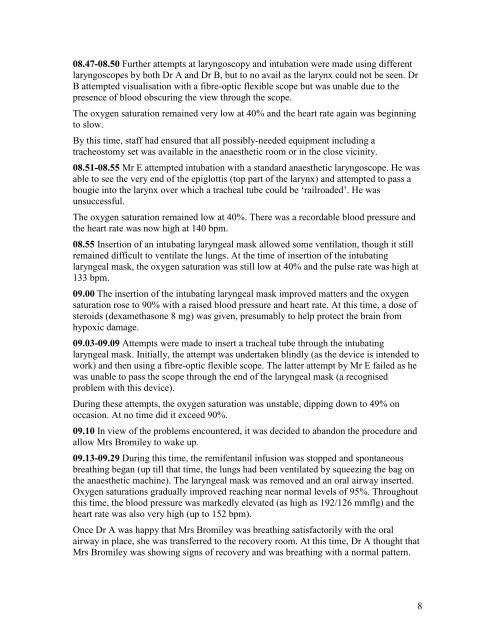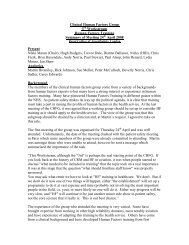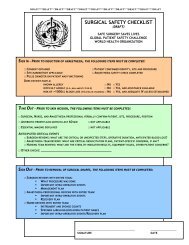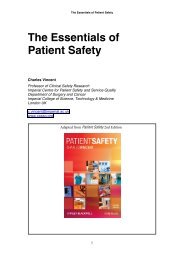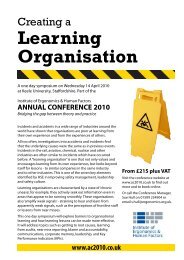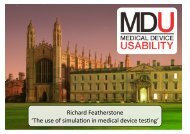Read an anonymous version of Elaine's report, the Inquest Verdict ...
Read an anonymous version of Elaine's report, the Inquest Verdict ...
Read an anonymous version of Elaine's report, the Inquest Verdict ...
You also want an ePaper? Increase the reach of your titles
YUMPU automatically turns print PDFs into web optimized ePapers that Google loves.
08.47-08.50 Fur<strong>the</strong>r attempts at laryngoscopy <strong>an</strong>d intubation were made using differentlaryngoscopes by both Dr A <strong>an</strong>d Dr B, but to no avail as <strong>the</strong> larynx could not be seen. DrB attempted visualisation with a fibre-optic flexible scope but was unable due to <strong>the</strong>presence <strong>of</strong> blood obscuring <strong>the</strong> view through <strong>the</strong> scope.The oxygen saturation remained very low at 40% <strong>an</strong>d <strong>the</strong> heart rate again was beginningto slow.By this time, staff had ensured that all possibly-needed equipment including atracheostomy set was available in <strong>the</strong> <strong>an</strong>aes<strong>the</strong>tic room or in <strong>the</strong> close vicinity.08.51-08.55 Mr E attempted intubation with a st<strong>an</strong>dard <strong>an</strong>aes<strong>the</strong>tic laryngoscope. He wasable to see <strong>the</strong> very end <strong>of</strong> <strong>the</strong> epiglottis (top part <strong>of</strong> <strong>the</strong> larynx) <strong>an</strong>d attempted to pass abougie into <strong>the</strong> larynx over which a tracheal tube could be „railroaded‟. He wasunsuccessful.The oxygen saturation remained low at 40%. There was a recordable blood pressure <strong>an</strong>d<strong>the</strong> heart rate was now high at 140 bpm.08.55 Insertion <strong>of</strong> <strong>an</strong> intubating laryngeal mask allowed some ventilation, though it stillremained difficult to ventilate <strong>the</strong> lungs. At <strong>the</strong> time <strong>of</strong> insertion <strong>of</strong> <strong>the</strong> intubatinglaryngeal mask, <strong>the</strong> oxygen saturation was still low at 40% <strong>an</strong>d <strong>the</strong> pulse rate was high at133 bpm.09.00 The insertion <strong>of</strong> <strong>the</strong> intubating laryngeal mask improved matters <strong>an</strong>d <strong>the</strong> oxygensaturation rose to 90% with a raised blood pressure <strong>an</strong>d heart rate. At this time, a dose <strong>of</strong>steroids (dexamethasone 8 mg) was given, presumably to help protect <strong>the</strong> brain fromhypoxic damage.09.03-09.09 Attempts were made to insert a tracheal tube through <strong>the</strong> intubatinglaryngeal mask. Initially, <strong>the</strong> attempt was undertaken blindly (as <strong>the</strong> device is intended towork) <strong>an</strong>d <strong>the</strong>n using a fibre-optic flexible scope. The latter attempt by Mr E failed as hewas unable to pass <strong>the</strong> scope through <strong>the</strong> end <strong>of</strong> <strong>the</strong> laryngeal mask (a recognisedproblem with this device).During <strong>the</strong>se attempts, <strong>the</strong> oxygen saturation was unstable, dipping down to 49% onoccasion. At no time did it exceed 90%.09.10 In view <strong>of</strong> <strong>the</strong> problems encountered, it was decided to ab<strong>an</strong>don <strong>the</strong> procedure <strong>an</strong>dallow Mrs Bromiley to wake up.09.13-09.29 During this time, <strong>the</strong> remifent<strong>an</strong>il infusion was stopped <strong>an</strong>d spont<strong>an</strong>eousbreathing beg<strong>an</strong> (up till that time, <strong>the</strong> lungs had been ventilated by squeezing <strong>the</strong> bag on<strong>the</strong> <strong>an</strong>aes<strong>the</strong>tic machine). The laryngeal mask was removed <strong>an</strong>d <strong>an</strong> oral airway inserted.Oxygen saturations gradually improved reaching near normal levels <strong>of</strong> 95%. Throughoutthis time, <strong>the</strong> blood pressure was markedly elevated (as high as 192/126 mmflg) <strong>an</strong>d <strong>the</strong>heart rate was also very high (up to 152 bpm).Once Dr A was happy that Mrs Bromiley was breathing satisfactorily with <strong>the</strong> oralairway in place, she was tr<strong>an</strong>sferred to <strong>the</strong> recovery room. At this time, Dr A thought thatMrs Bromiley was showing signs <strong>of</strong> recovery <strong>an</strong>d was breathing with a normal pattern.8


